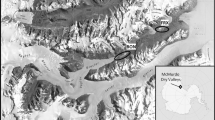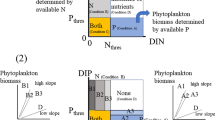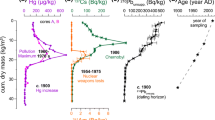Abstract
In situ carbon-14 bioassay techniques were used during 1972–1974 to estimate nutritional preferences and requirements of the pelagial phytoplankton in Lake Ohrid, Yugoslavia.
Bioassay measurements, conducted spatially and temporally, and corrected appropriately, showed a strong stimulation to phytoplankton photosynthesis rates during most seasons in epilimnetic waters following microadditions of inorganic silica and iron. Photosynthetic stimulation was additive for individual elements and synergistic when simultaneous additions were made. Marked stimulation occurred for both elements during the spring, especially in upper hypolimnetic waters (50–75 m) and correlated strongly with dominant diatom populations.
The addition of an organic chelator, nitrilotriaceticacid (NTA), commonly stimulated photosynthetic rates and, frequently, as deep as 15o m, considerably below the depth of optimal light availability for photosynthesis. With minor exception, the simultaneous addition of this chelator and inorganic iron were always capable of producing stimulatory responses.
Inorganic phosphorus was preferred over nitrogen and generally found to be more stimulatory. Phosphorus stimulation was restricted primarily to periods of spring and summer production. The addition of glucose, acetate and glycine produced positive responses, while the addition of several vitamins showed little effect except for a stimulation from microamounts of B12. The addition of two organic growth substances, Gibberellic acid (GA) and Indoleacetic acid (IAA), both stimulated phytoplankton photosynthesis.
The results of more than 140 bioassay measurements indicate the pelagial phytoplankton are severely restricted nutritionally due to specific physical-chemical interactions occurring in Lake Ohrid. Similar mechanisms have been postulated and evaluated in other hand-water lake systems. In spite of the great depth of the lake (300 m+) and probable age, these mechanisms are undoubtedly responsible for the low phytoplankton production occuring in the lake.
Similar content being viewed by others
References
Allen, H. L. & Ocevski, B. T. 1976. Limnological studies in a large, deep, oligotrophic lake (Lake Ohrid, Yugoslavia). Evaluation of nutrient availability and control of phytoplankton production through in situ radiobioassay procedures. Archiv fur Hydrobiologie 77: 1–21.
Goldman, C. R. 1968. The use of absolute activity for eliminating serious errors in the measurement of primary productivity with 14C. J.Cons. Intern. Explor. Mer 32: 172–179.
Goldman, C. R. & Mason, D. T. 1962. Inorganic precipitation of carbon in productivity experiments utilizing 14C. Science 136: 1049–1050.
Kozarov, G. 1954. Contribution à la connaissance de Cyclotella fotti, Hustedt, Diatomée planctonique du lac d'Ohrid. Rec. trav. Stat. Hydrobiol. Ohrid. Ann. II, 3 (9): 39–51. (In French, Yugoslavian summary).
Kozarov, G. 1957. Quantitative and qualitative studies of the phytoplankton of Lake Ohrid during a two year period. Unpubl. doctoral dissert. (In Yugoslavian).
Kozarov, G. 1958a. La production organique du phytoplancton dans le lac d'Ohrid. Rec. trav. Stat. Hydrobiol. Ohrid. Ann. VI, 4 (20): 1–12. (In Yugoslavian, French summary).
Kozarov, G. 1958b. Saturation of the upper heterothermic zone with oxygen in Lake Ohrid and its relation to the density of phytoplankton and water temperature. Rec. trav. Stat. Hydrobiol. Ohrid. Ann. VI, 14 (30): 1–12. (In Yugoslavian, English summary).
Kozarov, G. 1959. Organic production of phytoplankton in Lake Ohrid during the course of 1958. Rec. trav. Stat. Hydrobiol. Ohrid. Ann. VII, 11 (44): 1–10. (In Yugoslavian, English summary).
Kozarov, G. 1961. La répartition horizontale de certains représentants de phytoplancton du lac d'Ohrid dans la période MaiSeptembre 1959. Rec. trav. Stat. Hydrobiol. Ohrid. Ann. IX, 1 (50): 1–23. (In Yugoslavian, French summary).
Ocevski, B. T. & Allen, H. L. 1976. Limnological studies in a large, deep, oligotrophic lake (Lake Ohrid, Yugoslavia). Seasonal and annual primary production dynamics of the pelagial phytoplankton. Archiv für Hydrobiologie (In Press).
Stanković, S. 1960. The Balkan Lake Ohrid and its living world. Monographiae Biologicae Vol. 9. W. Junk, Den Haag, Netherlands. 357 pp.
Wetzel, R. G. 1965a. Nutritional aspects of algal productivity in marl lakes with particular reference to enrichment bioassays and their interpretation. Mem. Ist. Ital. Idrobiol., Suppl. 18: 137–157.
Wetzel, R. G. 1965b. Necessity for decontamination of filters in 14C measured rates of photosynthesis in fresh waters. Ecology 46: 540–542.
Wetzel, R. G. 1966. Productivity and nutrient relationships in marl lakes of northern Indiana. Verh. Internat. Verein. Limnol. 18: 321–332.
Wetzel, R. G. 1972. The role of carbon in hard-water marl lakes. Amer. Soc. Limnol. Oceanogr. Spec. Symp. 1: 84–97.
Author information
Authors and Affiliations
Rights and permissions
About this article
Cite this article
Allen, H.L., Ocevski, B.T. Limnological studies in a large, deep, oligotrophic lake (Lake Ohrid, Yugoslavia). A summary of nutritional radiobioassay responses of the pelagial phytoplankton. Hydrobiologia 53, 49–54 (1977). https://doi.org/10.1007/BF00021231
Received:
Published:
Issue Date:
DOI: https://doi.org/10.1007/BF00021231




